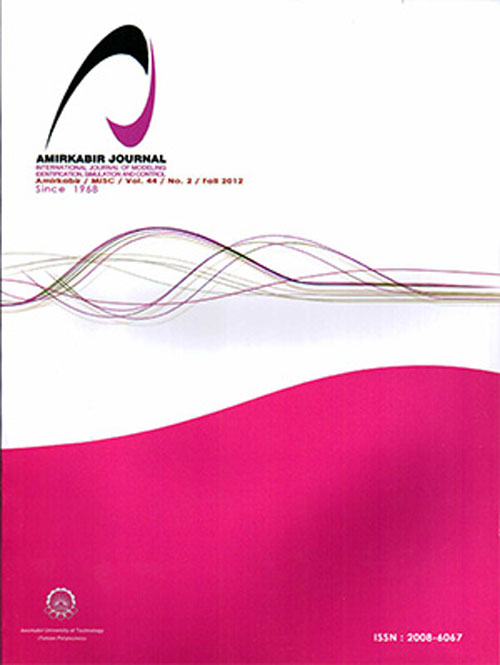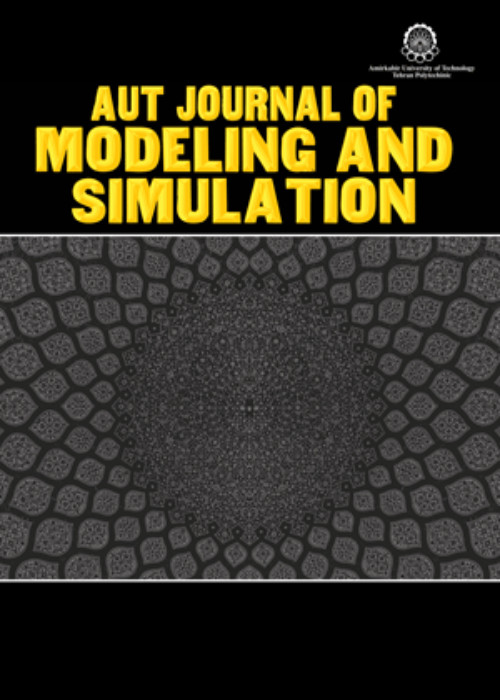فهرست مطالب

Journal of Modeling and Simulation
Volume:48 Issue: 2, Autumn 2016
- تاریخ انتشار: 1395/10/05
- تعداد عناوین: 6
-
-
Pages 65-74A method for solving the descriptor discrete-time linear system is focused. For easily, it is converted to a standard discrete-time linear system by the definition of a derivative state feedback. Then partial eigenvalue assignment is used for obtaining state feedback and solving the standard system. In partial eigenvalue assignment, just a part of the open loop spectrum of the standard linear systems are reassigned, while leaving the rest of the spectrum invariant and for reassigning, similarity transformation is used. Using partial eigenvalue assignment is easier than using eigenvalue assignment. Because by partial eigenvalue assignment, size of matrices and state and input vectors are decreased and stability is kept, too. Also concluding remarks and an algorithm are proposed to the descriptions will be obvious. At the end, convergence of state and input vectors in the descriptor system to balance point (zero) are showed by figures in a numerical example.Keywords: Descriptor discrete, time system, Derivative state feedback, Partial eigenvalue assignment, Converge to balance point
-
Pages 75-92Evolving models have found applications in many real world systems. In this paper, potentials of the Evolving Linear Models (ELMs) in tracking control design for nonlinear variable structure systems are introduced. At first, an ELM is introduced as a dynamic single input, single output (SISO) linear model whose parameters as well as dynamic orders of input and output signals can change through the time. Then, the potential of ELMs in modeling nonlinear time-varying SISO systems is explained. Next, the potential of the ELMs in tracking control of a minimum phase nonlinear time-varying SISO system is introduced. For this mean, two tracking control strategies are proposed respectively for (a) when the ELM is known perfectly and (b) when the ELM model has uncertainties but dynamic orders of the input and output signals are fixed. The methodology and superiority of the proposed tracking control systems are shown via some illustrative examples: speed control in a DC motor and link position control in a flexible joint robot.Keywords: Evolving linear model, nonlinear time, varying systems, tracking control system
-
Pages 93-102Project planning is part of project management, which is relates to the use of schedules such as Gantt charts to plan and subsequently report progress within the project environment. Initially, the project scope is defined and the appropriate methods for completing the project are determined. In this paper a new approach for the critical path analyzing a project network with random fuzzy activity times has been proposed. The activity times of a project are assumed to be random fuzzy. Linear programming formulation has been applied to determine the critical path. The critical path method (CPM) problem has been solved using the expected duration optimization model and the mean-variance model, along with Lius definition for random fuzzy variables. Furthermore, a numerical example problem is solved for illustrating the proposed method.Keywords: Critical Path Method (CPM), Activity Times, Random Fuzzy Time, Triangular Fuzzy Numbers, Normal Distribution
-
Pages 103-110Usually, in monitoring schemes the nominal value of the process parameter is assumed known. However, this assumption is violated owing to costly sampling and lack of data particularly in healthcare systems. On the other hand, applying a fixed control limit for the risk-adjusted Bernoulli chart causes to a variable in-control average run length performance for patient populations with dissimilar risk score distributions in monitoring clinical and surgical performance. To solve these problems, a self-starting scheme is proposed based on a parametric bootstrap method and dynamic probability control limits for the risk-adjusted Bernoulli cumulative sum control charts. The advantage of the proposed control charts lies in the use of probability control limits when any assumptions about the patients risk distributions and process parameter. Simulation studies show that both proposed schemes have good performance under various shifts.Keywords: Average run length, Self, starting monitoring, Bernoulli process, Probability control limits, surgical performance
-
Pages 111-122Linear state bisection is introduced as a new method to find time-invariant state feedback control laws for a special form of underactuated nonlinear systems. The specialty of the systems considered is that every unactuated state should be coupled with at least two directly actuated states. The basic idea is based on bisecting actuated states and using linear combinations with adjustable parameters to stabilize the unactuated states. These linear combinations make the underactuated system virtually fullyactuated, making it suitable to be stabilized with well-known nonlinear control methods, like feedback linearization. In addition to its simplicity, one of the main contributions of this method is that it can be applied to systems with more than one unactuated state. Three underactuated systems are considered: an asymmetric rigid body, a planar rigid body with an unactuated internal degree of freedom and a system with two degrees of underactuation. It is shown through simulations that the proposed control laws can be effectively used to stabilize the special form of underactuated systems considered.Keywords: Underactuation, Feedback linearization, State bisection
-
Pages 123-138This paper deals with leader-following and leaderless consensus problems of high-order multi-input/multi-output (MIMO) multi-agent systems with unknown nonlinear dynamics in the presence of uncertain external disturbances. The agents may have different dynamics and communicate together under a directed graph. A distributed adaptive method is designed for both cases. The structures of the controllers simplify their implementation and reduce computational cost. Unknown nonlinearities are estimated by a radial basis function neural network (RBFNN). The ultimate boundness of the closed-loop system is guaranteed through Lyapunov stability analysis by introducing a suitably driven adaptive rule. Finally, the simulation results verify performance of the proposed control method.Keywords: Adaptive control, Consensus, MIMO systems, neural networks, multi, agent systems


